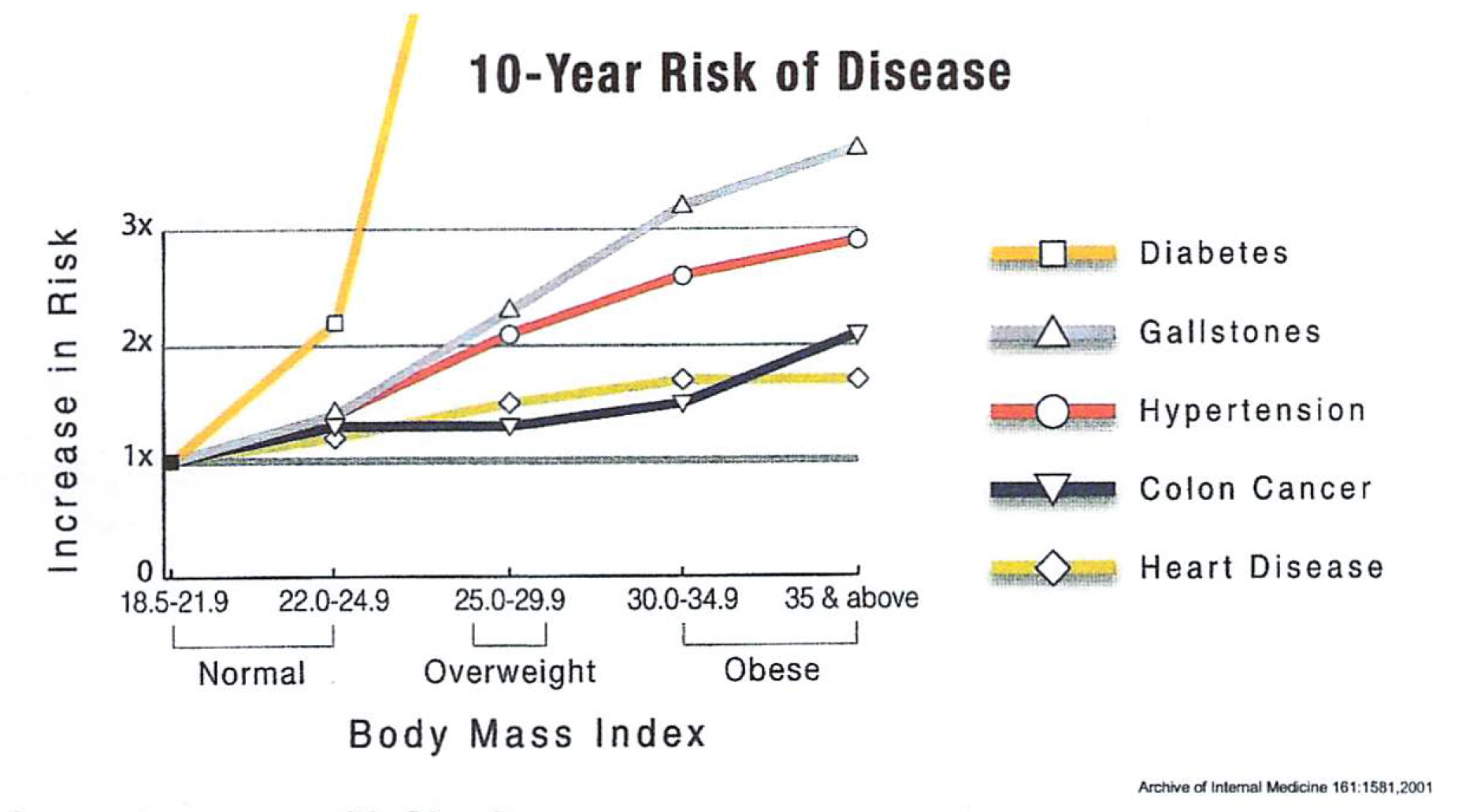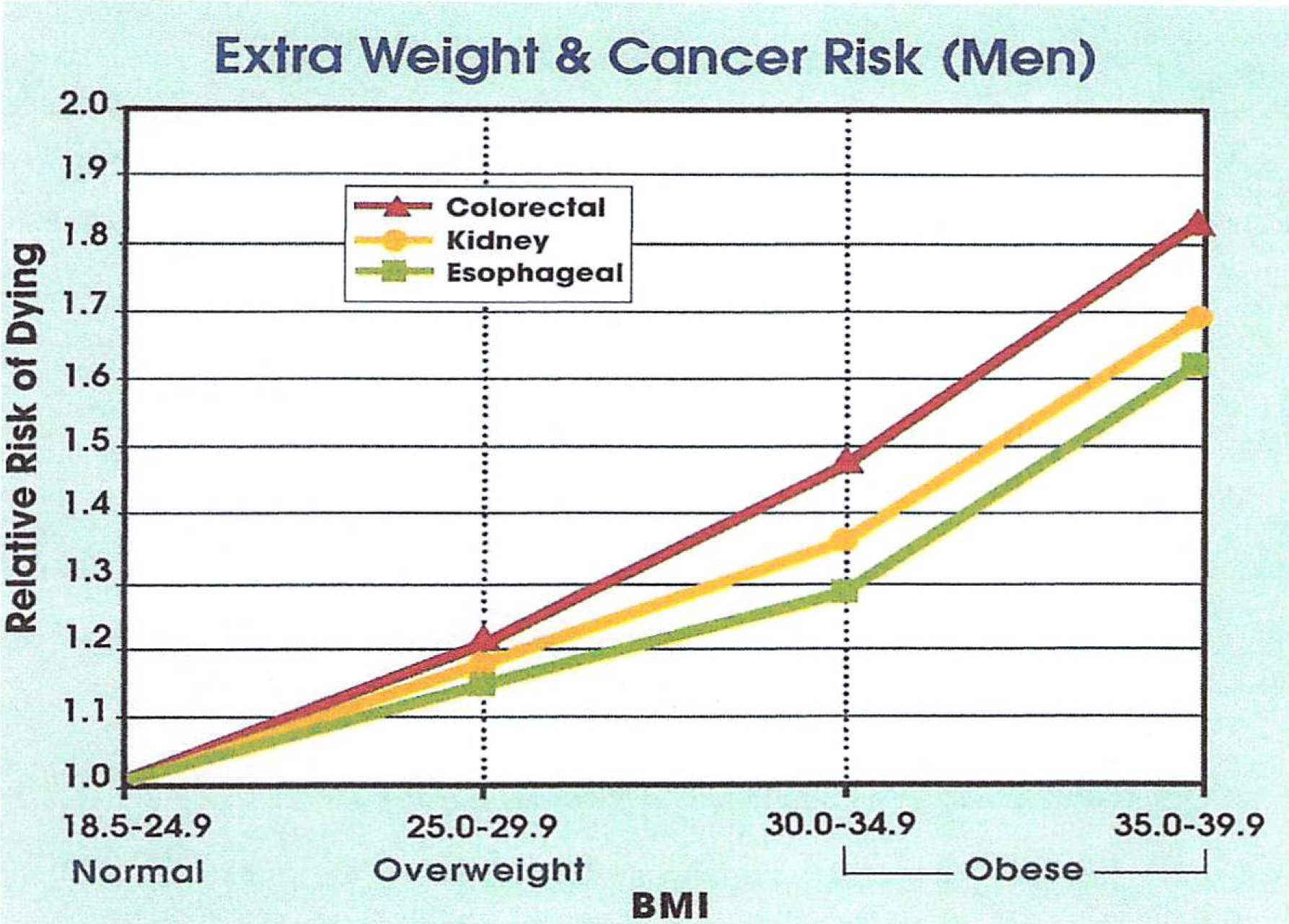General
Obesity presents one of the greatest threats to healthy aging. In 1995, an estimated 52 billion US dollars was spent to treat patients with morbid obesity or 5.7% of all US health care expenditures. In 1999, this number was revised to 100 billion with over half of the population in the United States estimated to be overweight and 23% morbidly obese. Furthermore, obesity as a disease of Western society is expected to continue to increase markedly over the next two decades.
Obesity is defined as:
- An increase in the number and size of adipocytes in fat tissue
- Body Mass Index (BMI) of 30 or more
Obesity is classified as a disease, as the overall mortality rate of the morbidly obese population has been demonstrated to be approximately double that of the normal weight population. More staggering is the realization that in the 25 to 34 year old male-agegroup the same mortality rate is increased 12 fold. This increase in mortality is explained by the medical conditions or co-morbid factors frequently associated with morbid obesity.
Obesity Classification
| Classification | BMI | BMI Class |
|---|---|---|
| Underweight* | < 18.5 | 1 |
| Normal | 18.5-24.9 | 2 |
| Overweight | 25-29.9 | 3 |
| Obesity Class 1 | 30-34.9 | 4 |
| Obesity Class 2 | 35-39.9 | 5 |
| Obesity Class 3 | > 39.9 | 6 |
* The body weights associated with the greatest longevity are actually below the average weights of the U.S. population, assuming such weights are not associated with illness (NNIH Nutrition Committee and Centers for Disease Control)
Incidence of Obesity
- In 1960
- o < 5% of Americans were obese
- Today
- 1/3 of Americans are Overweight (BMI of 25 or more)
- 1/3 of Americans are Obese (BMI of 30 or more)
- The prevalence of obesity increased 74% from 1991 to 2001
- Clinically severe obesity quadrupled from 1 in 200 in 1986 to 1 in 50 in 2000
- Childhood obesity has tripled in the past 20 years
- With obesity comes diabetes. The number of children with type II diabetes increased 500% during the 1990s and the rate has doubled again since then
- Rate of obesity increases
- 75% increase in the past 3 decades
- 61 % increase since 1991
- Clinically severe obesity quadrupled from 1 in 200 in 1986 to 1 in 50 in 2000
- Future
- Obesity is expected, within a few years, to become the number one preventable cause of death in the U.S. (currently, it is ranked second)
- ‘Overnourishment’ will soon outpace malnutrition in the poorer half of the world
Even modest weight loss can reduce the morbidity of obesity-related disease, such as arthritis and obstructive sleep apnea. For those at increased risk of death from cardiovascular disease, such as persons with obesity and diabetes mellitus, intentional weight loss coupled with lifestyle change can significantly reduce mortality
Causes of Obesity
- Imbalances between energy intake and energy expenditure
- The average American consumes 500 more calories/day than in 1970.
- Nutritional imbalances
- Macronutrients
- Micronutrients
- Too many calories
- Hormone imbalances and resistance
- Lack of activity
- Lack of sleep
- Relationship to obesity
- 2-4 hours sleep: 73% more likely to be obese
- 5 hours sleep: 50% more likely to be obese
- 6 hours sleep: 23% moer likely to be obese
- Less than 7 hours sleep
- 15% higher appetite-stimulating hormone, ghrelin
- 15% lower leptin
- Chronic Sleep Deprivation
- Decreases insulin sensitivity
- Increases cortisol levels
- Raises TSH
- Decreases leptin levels and increases leptin resistance
- Increases Ghrelin levels
- Decreases glucose tolerance
- Increases neuropeptide Y (carbohydrate hunger)
- Increases Galanin (fat hunger)
- Relationship to obesity
Cost of Medical Care rises with Obesity
- Obese Americans spend 36% more on health services and 77% more on medications (Smokers use 21 % more health services and 28% more medications)
- Annual medical costs for the obese are 38% higher than for the lean
- 14% of overall health care costs are driven by overweight Americans
- Left unchecked a growing number of aging overweight Americans will drive that avoidable cost figure to 21% in 15 years
- Direct medical costs account for $93 billion a year in added medical expenses (compared to $76 billion a year for smoking-related care) and approximately $117 billion overall (2002)
- Obese Medicare beneficiaries cost $1486/year more
- Obese Medicaid beneficiaries cost $64/year more
- Left unchecked a growing number of aging overweight Americans will drive that avoidable cost figure to 21 % in 15 years
Mortality and Obesity
- U.S. Surgeon General Richard Carmona, MD, called childhood obesity the greatest threat to public health today: “It kills more Americans every year than AIDS, all cancers and all accidents combined. And it’s causing problems in children that were unthinkable 20 years ago.
- Obesity significantly increases the risk of all the major causes of death in the U.S. – heart disease, stroke, cancer, diabetes
- Obese adult shave 50-100% greater risk of premature death
- Obesity causes 400,000 preventable deaths of Americans annually, second only to smoking related deaths (435,000)
- Chronic disease accounts for 7 out of every 10 U.S. deaths and more than 60% of medical care expenditures
- Nurses’ Health Study
- The lowest mortality rate was found in those with BMls around 19
- The risk of death for all causes increased by 20% as the BMI increased
- from 19 to 25, by 60% as it rose to 28, and by more than 100% for BMls of 29 and higher
- BMI of 30 or more is associated with a 50-100% increase in all-cause mortality
Health Risks increase with Obesity
(Comparing Americans with a BMI of 18.5-24.9 VS. those with a BMI of 40+)
- 80% of obese suffer from at least one chronic health condition
- 7.37 times greater risk of becoming diabetic
- 6.38 times greater risk for hypertension
- 1.88 times greater risk for hyperlipidemia
- 2.72 times greater risk for asthma
- 4.41 times greater risk for arthritis
- 2 times greater risk for stroke (men with BMI over 30 compared to 20-23)

Cancer increases with Obesity
- Being overweight/obese is associated with 100,000 cancer cases annually in the U.S. Distribution by type:
- Breast cancer 11 %
- Colon cancer 14%
- Endometrial cancer 49%
- Esophagealcancer39%
- Kidney cancer 31 %
- Non-Hodgkin’s lymphoma 20%
- Pancreatic cancer 14%
- Overweight women are 50% more likely to die of cancer
- 33% more cases of cancer occur among obese people (including Hodgkin’s, cancers of the endometrium, kidney, gallbladder, colon, pancreas, bladder, cervix, ovary, brain, Non-Hodgkin’s lymphoma, liver, small bowel, larynx)
- Overweight people have a 70% greater chance of developing pancreatic cancer
- The fittest men are half as likely to die from cancer


Obesity and Silent Inflammation
Obesity is among the biggest factors underlying the cause of most aging-related diseases – chronic silent inflammation. Body fat secretes dozens of hormones and peptides:
- Regulating sensitivity to other hormones
- Regulating appetite and cell function
- Leptin
- Adiponectin
- Ghrelin
- Pro-inflammatory
Obesity increases IL-1B, TNF- alpha, and IL-6 which reduce adipokines such as adiponectin. Excessive inflammation has been recognized as a cause of or contribution to heart attacks, strokes, diabetes, many cancers, metabolic syndrome, Alzheimer’s
disease, asthma, rheumatoid arthritis, systemic lupus erythematosis (SLE), and atherosclerosis.
Other Disease Risks associated with being Overweight/Obese
- Sleep apnea
- Osteoarthritis
- Gallbladder disease
- Metabolic syndrome
Longevity is Shortened by being Overweight-Obese
- Non-smokers who are overweight (but not obese) lose an average of 3 years off their life
- Obese female non-smokers lose an average of 7.1 years
- Obese male non-smokers lose an average of 5.8 years
- The weights associated with the greatest longevity are below average weights of the population, as long as such weights are not associated with illness (NNIH Nutrition Committee and Centers for Disease Control)
Fat in All the Wrong Places
- People can make new fat cells at any age
- Even new fat cells may not be enough to store excess fat
- It accumulates in liver, muscle, heart, and pancreas
- Leading to insulin resistance
- When you diet, you primarily reduce the amount of fat stored in a cell, not the number of cells
Workplace and Obesity
- Those who exercise and maintain a healthy body weight take fewer sick days than overweight colleagues
- Obese workers have more social difficulty in the workplace. translating into decreased productivity
Obesity is Responsible for
- 25% of adults have metabolic syndrome
- 85% of diabetics are classified as type 2 and of those 90% are obese. The risk of developing diabetes increases as BMI increases beginning at a BMI of 22
- 50-70% of CHD
- 70% of gallstone attacks
- 35% of hypertension
- 11 % of breast cancers
- 10% of colon cancers
- Morbidity increases for these conditions as the BMI rises above 20
- Hypertension
- Type 2 diabetes
- Dyslipidemia
- Coronary heart disease
- Congestive heart failure
- Stroke
- Gallbladder disease
- Hyperuricemia/gout
- Osteoarthritis
- Complications with pregnancy
- Respiratory problems
- Cancers of the endometrium, breast, prostate
- Sleep apnea
- Infertility/menstrual irregularities
- Hirsutism
- Stress incontinence
- Psychological disorders